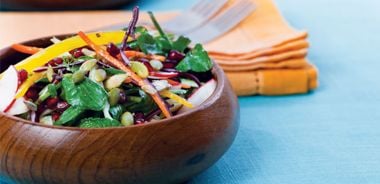Rainbow Coleslaw

1 Tbsp (15 mL) sunflower, sesame, or pumpkin seeds (for toasting)
1/2 cup (125 mL) bean or mixed sprouts (sunflower, broccoli, or pea shoots)
1/2 cup (125 mL) green cabbage, shredded
1 cup (250 mL) red cabbage, shredded
1 bunch watercress
1 cup (250 mL) carrots, grated
3 to 4 red radishes, cut into half moons
1/2 cup (125 mL) yellow peppers or zucchini, julienned
1/2 to 1 cup (125 to 250 mL) fresh herbs, such as dill, fennel, thyme, parsley, cilantro, or mint, loosely packed (optional)
1/2 cup (125 mL) fresh pomegranate seeds (optional)
Dressing
1/4 cup (60 mL) cold-pressed extra-virgin olive oil
2 Tbsp (30 mL) cold-pressed sesame oil
3 Tbsp (45 mL) apple cider vinegar or fresh lemon juice
2 Tbsp (30 mL) maple syrup or raw honey
2 to 3 Tbsp (30 to 45 mL) stone ground mustard
2 cloves garlic, minced
1 in (2.5 cm) piece fresh ginger, minced
Lightly toast seeds for topping at 200 F (95 C) or lower to preserve delicate inner oils, for approximately 10 minutes until slightly browned.
In large bowl, combine all salad ingredients, except toasted seeds and pomegranate seeds.
In small bowl, mix oils, vinegar or lemon juice, maple syrup or honey, mustard, garlic, and ginger; adjust to taste.
Before serving, pour dressing over salad and toss gently. Sprinkle with toasted seeds and fresh pomegranate seeds (if desired) and serve.
Serves 4.
Each serving contains: 298 calories; 3 g protein; 23 g total fat (3 g sat. fat, 0 g trans fat); 21 g carbohydrates; 4 g fibre; 205 mg sodium
source: "A Fighting Chance", from alive #342, April 2011




